Europe Steps Up Counter-UAS Efforts – JED, October 2020
– By Andrew White –
The European Counter Unmanned Aerial System (C-UAS) market continues to promise significant growth for armed forces and security agencies seeking to not only protect critical national infrastructure at home but also forward deployed personnel operating abroad. Some of the most notable European programs, which continue to be pursued over the course of 2020 despite some hold ups associated with the ongoing COVID-19 pandemic, include procurement efforts in Denmark, Finland, Germany and Lithuania to name just a few. However, despite benefiting from several years of frantic research, development and procurement activities, the European C-UAS market remains in a relatively early stage of development, as customers continue to tweak requirements to support an ever-expanding envelope of potential mission sets. A one-size-fits-all solution appears as far away as ever in terms of a C-UAS capability.
Nevertheless, European defense departments and industry continue to explore emerging technologies designed to satisfy urgent operational requirements arising from theaters around the world. Specific areas of interest include Artificial Intelligence (AI) and Machine Learning (ML) algorithms designed to assist in the recognition of threats; autonomous capabilities to help counter swarms of UAS; high-definition (HD) and three-dimensional (3D) sensors and radars; and finally, the integration of C-UAS systems into wider air defense networks.
STILL MATURING
Rheinmetall Air Defense Systems Program Manager, Matthias Diem, described how the European C-UAS market is reaching a mature level. “The first wave of the market was quite simple; stand-alone sensor solutions from various vendors were installed in the field without any networked capability and concept of operations,” he said. “Today, we reach the second wave of the market where we can see that C-UAS solutions must be integrated into higher echelons to allow multi-agency capabilities. High degrees in automation and low false alarm rates are key but also essential is the efficient use of C-UAS staff. This second wave has reached certain countries in Europe which are now preparing the third wave – fully integrated C-UAS systems with the capability to integrate highly autonomous effectors.”
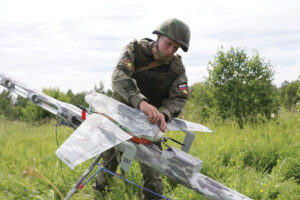
According to Diem, the most critical capability gap facing the C-UAS market in Europe is the lack of a complete local air picture. New sensor technologies, he said, are capable of filling this gap for stationary and mobile military platforms. “There are sensors and systems on the market which are quite capable already,” he explained, “but the seamless integration into a sophisticated C2 [command and control] system is the key to success. Only a redundant sensor fusion with the right effector mix – lethal and non-lethal for stationary and mobile platforms – will pave the way for the future of modern air defense. Many armed forces have recently suffered from a lack of this capability and are now evaluating the latest SHORAD [short range air defense] systems – with a high focus on mobile air defense capabilities,” he added.
Referring to the contemporary operating environment, where forward-deployed armed forces continue to be threatened by the “wide use of weaponized drones,” Diem described how C-UAS and wider air defense solutions must be equipped to handle “highly connected swarms of drones.” “C-UAS equipped with AI features will be one the most crucial challenges to all air defense forces,” he said. “Thus, customers are taking this into consideration while shaping their future requirements.”
On July 30, Germany’s Federal Office for Equipment of the Bundeswehr (BAAINBw) selected a consortium featuring Rohde & Schwarz, ESG and Diehl to supply an undisclosed number of “Guardion” C-UAS solutions. Designed to “detect, classify, identify and counter” small unmanned aerial vehicles, Guardion systems will be tasked with the force protection of military bases around the World.
Featuring Hensoldt’s Spexer 2000D radar and Night Owl cameras, in addition to R&S’s Ardronis direction finding equipment, Guardion detects radar, visual, RF and acoustic signatures of UAS targets and then processes data using ESG’s Taranis C2 software. “Ardronis detects, classifies and determines the direction of drone remote controls, prohibits remote control between the pilot and the drone, thereby preventing the silent approach of unmanned aerial vehicles,” a company spokesperson for Rohde & Schwarz described in a statement. The system can “detect and prevent unauthorized situations with UAS by continuously monitoring the frequency bands used by unmanned vehicle remote controls and generating an alert when a remote control is activated. This gives security personnel the earliest possible warning, saving valuable time for clarifying the situation,” it added.
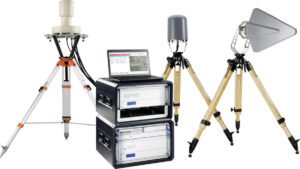
Ardronis also provides the Guardion’s countermeasures response, which jams the drone’s C2 link and GPS receiver. “Detected and identified targets are neutralized by disrupting communication with the command post or satellite navigation system,” according to the company. “When the radio link is interrupted, drones usually enter failsafe mode and are not able to continue flying. Ardronis only disrupts the control signals of UAVs previously identified as unauthorized, without affecting other radio links in the same frequency band. The system also uses effectors in the form of electromagnetic weapons or fired nets. Open architecture allows for the introduction of additional measures to detect and combat drones,” the statement concluded.
MOBILITY
Meanwhile, Norwegian company Kongsberg Defence and Aerospace continues to integrate solutions on board a variety of tactical ground vehicles as it considers more mobile applications for C-UAS technology in support of the German Armed Forces and the wider international market. The company’s vice president for marketing and sales, land systems, Arne Gjennestad, explained how the UAS threat continues to grow as does the capability to defend against such threats. “This is currently a key requirement in many programs,” he said. “There is no solution that fits all requirements, threats and scenarios. We need to have a flexible toolbox with different capabilities.” He went on to explain, “There are also systems that will be designated C-UAS systems, specifically for high-value targets. But for regular units, there may not be available funding, personnel or space to buy, operate or mount a C-UAS capability. So it is important that C-UAS kits can be an add-on in order to allow the customer to achieve cost-effective solutions using what he already has, with no more manning or no more equipment.”
Kongsberg is currently working with the German Armed Forces to provide a capability to protect tactical ground vehicles against UAS operating as part of the NATO Very High Readiness Joint Task Force (VJTF) deployment to Eastern Europe in January 2023. “After studies of different concepts, the BAAINBw (acquisition organization) launched a competitive tender, including a test and demonstration firing. The contract was awarded in December 2019 after an international bidding process. The program is now running in accordance with an agreed program execution plan,” Gjennestad confirmed.
Kongsberg’s solution comprises a C-UAS capability integrated onto the company’s own Protector remote weapon station (RWS), which will use a Heckler & Koch 40-mm Automatic Grenade Launcher with programmable airburst munitions to defeat target UAS. “The RWS is connected to a radar sensor, which provides surveillance of the airspace for detection and tracking of UAS,” he said. “After detection of the UAS, the Protector Fire Control system provides a target priority list focused on the highest threatening target at that particular time. The operator is then able to directly slew the RWS’s C-UAS payload onto the selected target before automatic tracking is conducted by a multi-sensor tracker, which uses the best available sensor or a combination of these to follow
the target. Options include radar, thermal imager or visual imager, assisted by the Laser Range Finder. When engaging the target, the grenades will be programmed to explode in a specific pattern based on direction of movement of the target,” Gjennestad added.
The solution also includes Hensoldt’s Spexer 2000 3G radar, following its selection by the German Armed Forces. Kongsberg’s solution for the Germany Armed Forces will not include a soft-kill capability. “The program is moving forward in accordance with an agreed program plan. The complete German system should be operational and part of their VJTF participation 2023,” Gjennestad confirmed.
Gjennestad also explained how Kongsberg could integrate a 30-mm x 113-mm cannon with airburst/proximity ammunition into the Protector C-UAS solution, in order to provide end users with several choices for engaging UAS based on their characteristics. Further integration of additional sensors includes integration with additional radars and acoustic sensors which remain ongoing efforts for the company.
Kongsberg is also considering the integration of tactical C-UAS on board unmanned ground vehicles (UGVs). Gjennestad said, “The ability for an operator to control several Protector systems at the same time via a multi-station control, as well as the ability to have a secure fire control for remote/wireless control of the RWS, provides an opportunity for UGVs.”
INTEGRATED SOLUTIONS
In the UK, Leonardo continues to work on a three-year C-UAS contract on behalf of the Royal Air Force (RAF) following its down-selection in September 2019. Managed in conjunction with the MOD’s Defence Equipment & Support Future Capability Group, the Counter-Drone Research Program is aimed at “reinvigorating” research and development in terms of understanding requirements for a “future core capability which will be able to respond to rapidly-evolving threats posed by hostile drones,” according to a company statement. The program, which officially started in the first half of 2020, is tasked with understanding how C-UAS operators will be able to detect, track, identify and defeat rogue drones in the future operating environment.
Last month, the company announced that it had delivered the first of four complete baseline ORCUS C-UAS systems to the RAF for evaluation. According to a statement from the MOD, successful testing of the full range of integrated detect, track, ID, and defeat technologies, enabled the program to achieve an Initial Operating Capability. Understood to include technology from Leonardo as well as sub-contractors Metis Aerospace and SRC Inc., the ORCUS utilizes a modular architecture that comprises radar, electro-optic and radio frequency sensors to detect and track UAS, and an electronic attack subsystems to defeat the target. While the ORCUS is currently part of the RAF study program, the RAF is ultimately seeking a C-UAS capability to protect air bases both at home and abroad.
Leonardo’s sales manager for integrated sensing and protection, Andy Roberts, described how the European market continues to increase with interest in both and civil applications. “Whilst these are likely to have different requirements in terms of performance and the potential utility of effectors,” he said, “it is something we are continuing to monitor closely. The market is also becoming more informed as time progresses, this means that customers are refining their requirements, which is a great enabler for us in industry.”
Leonardo’s offering, Falcon Shield, is already in service with the RAF, as well as the Italian Army and the Italian Air Force in a force protection role having benefited from critical lessons learned while performing similar protection duties at London Heathrow and Gatwick airports in 2018.
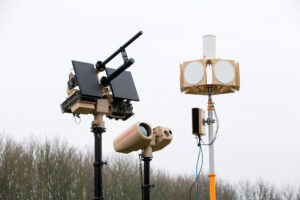
Falcon Shield comprises an integrated system of sensors and effectors, capable of detecting, tracking, identifying and defeating drones at long range. As Roberts explained, “It draws on our abilities as a system integrator to utilize best-of-breed detection technologies, coupled with our thermal imaging and electronic warfare technologies to provide a capability that can both identify and defeat drones before they are able to have a physical or surveillance effect on the user.” He added, “We continue to monitor the development of drone technologies so as to enable future enhancements to both our detection and defeat capabilities. We are also looking at methods of deployment of these technologies to suit a number of different operational scenarios.”
Positioning itself as a systems integrator in the European and international C-UAS market is the UK’s Chess Dynamics, with sales director Dave Eldridge describing how today, customers are able to choose between “hundreds” of C-UAS capabilities. Reiterating that the C-UAS market is unlikely to ever see a “silver bullet” solution, Eldridge explained how the future of C-UAS solutions will require the technology to be integrated into larger air defense networks, allowing them to contribute towards and benefit from combined air pictures.
“C-UAS can’t afford to stand outside of that,” Eldridge warned before suggesting the integration of tactical C-UAS systems into more operational and strategic air defense networks might slow down procurement programs in the future. “A properly structured C-UAS military program is probably going to happen in the next two years. But as has been the case to now, urgent operational requirements will continue to be the trend instead of proper equipment evaluation,” Eldridge added.
In order to keep pace with Europe’s rapidly emerging C-UAS market, Chess continues to observe a series of emerging technologies, including 3D radars and HD thermal imaging sensors, both of which would increase operating efficiency. “HD thermal imaging is becoming available and moving forward,” he said. “In the future, all sub-systems sensors are going to be HD, be they thermal imagers or day cameras.” Chess is also exploring the ability of AI and ML algorithms to assist in the automatic detection and classification of targets through its subsidiary Vision4ce. Such a capability means customers would be able to create a UAS threat library. “Video classification to us is a gamechanger,” he stressed.
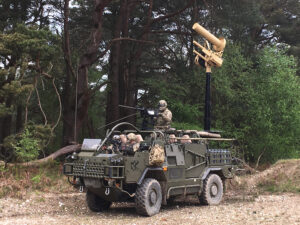
According to Eldridge, the more sub-systems and sensors which can be integrated into a wider C-UAS and air defense solution, the better it will be. “In the military context, it’s all about understanding what system is right for a particular application. Systems must also be agnostic to defeat and detection mechanisms, providing end users with a service capability.”
In terms of defeat mechanisms, Eldridge explained how directed energy was quickly becoming a plausible solution in addition to RF jammers and hard-kill munitions and missiles. “Soft kill is responsible for 95% of solutions out there at the moment,” he said. “But if a drone is coming on a pre-programmed flight path, it’s no good taking out its navigation systems. Military doctrine therefore, will require end users to be able to hand off to a directed energy or kinetic solution in the future.”
Thales is another major European solutions provider which is focused on exploiting Big Data, Connectivity, AI and Cyber Security to further enhance C-UAS solutions in the future. “We fully expect the market to develop, and indeed we are working on very innovative developments in the C-UAS field for deployment across the next 10 years, including countering swarms of drones,” said a company spokesman. “These are drones that act in total coordination with one another mimicking the behavior of certain biological organisms like bees or starlings.”
Unable to provide further details due to competitive sensitivities, the Thales spokesperson confirmed how the company continued to offer up its ForceShield C-UAS system, which comprises an air defense system designed to intercept any air threats, from small UAS up to combat aircraft. It includes a command, control and communications suite, which is networked to hard-kill effectors, including Starstreak and Light Multirole missiles.
Another Thales offering is EagleShield which comprises a multi-sensor solution capable of detecting, identifying, classifying and neutralizing rogue drones flying at low altitude at ranges of up to 7 km. This solution also incorporates the Gamekeeper holographic radar which provides 3D coverage over a 90-degree field of view and can be networked to infrared and RF sensors which refine the system’s threat identification and classification performance “using sophisticated real-time data fusion techniques to determine the exact type of unmanned aircraft involved,” the spokesperson said.
WEARABLE UAS DETECTION
At the lowest tactical level, Danish C-UAS specialist MyDefence Communications is in the process of equipping Lithuanian forces with C-UAS solutions which can be worn on the soldier, integrated on board vehicles or operated in a fixed-site configuration to protect operating bases.
The company’s CEO, Dan Hermansen, described several established as well as emerging C-UAS mission areas, including critical infrastructure protection, border control, point protection and wearable security.
“In the European MODs,” he said, “there is a clear lack of C-UAS capabilities. With the exception of special forces, land forces in general are missing out on equipment for countering low, slow and small air threats. The same goes for naval and air forces, which paints a picture of a serious gap in the armed forces, as equipment used for early warning and self-protection is missing.” He said the Technology Readiness Level (TRL) of most systems is already at TRL 9, now is a good time for MoDs to progress their procurement plans and make specific calls for action.
MyDefence solutions include the Wingman-105 Small Handheld/Wearable Drone Detector, which is supported by the Watchdog 200 Networked RF Sensor. Comprising a lighter weight version of MyDefence’s Wingman-100, the -105 model is capable of detecting drone threats out to a range of approximately 1,000m through 60-degree directional 2.4GHz and 5.8GHz ISM band antennas. Hermansen described how the Wingman-105 could be worn around the wrist, providing end users with non-audible alerts of UAS in the immediate area. The capability also includes the AA100 external Active Antenna (AA100) – an omni-directional antenna which can be added on for 360-degree coverage and lower ISM-band frequencies, dependent upon customer preferences. The AA100 was originally developed in 2017 in cooperation with the US Army to cover normal ISM-bands, with multiple parallel active receiver chains designed to make the solution versatile enough to quickly counter threats in new frequency areas.
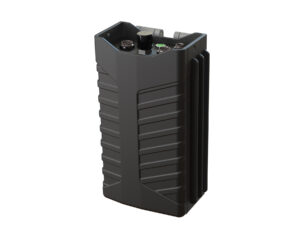
Based on the rapid developing UAS-threat from ISIS and other violent extremist organizations around the World, the frequency band around 1.2-1.3 GHz was quickly added to the solution, making it capable of detecting drones using analog video for FPV goggles, Hermansen described. “In a matter of days, the new drone threats were available in the library and the Wingmans were updated in theater with the Field Upgrade Tool FT100 simply by downloading the new firmware from a secure site and copying it to an SD-card for firmware update to start.” The newest accessory to the Wingman family is the Vibrator Dongle VD100, which was custom developed for the Lithuanian MOD to enable troops to stay protected from drones without jeopardizing stealth.
MyDefence has also designed the Watchdog 200 (WD200) as its “next evolution” for the C-UAS market, comprising a portable solution featuring direction finding and the Iris C2 system. In stand-alone mode, the WD200 quad mount features four mounted and perpendicular sensors covering 360 degrees with an accuracy of 5 degrees RMS. When two or more tripods are networked, the system achieves the ability to geolocate RF transmitters and thereby start tracking drones and pilots based on their RF emissions.
In August, MyDefence hosted a demonstration for the Danish MOD that illustrated the capabilities of the Watchdog system with geolocation capability. A total of three quad mounts were used to cover a larger area, sharing data across a wireless network to demonstrate how both drone and pilot can effectively be geolocated in real-time, Hermansen described. This new geolocation feature will be released to customers later this year, and further end-user trials have been planned in Europe, Middle East and North America in the coming months, he added.
KEEPING PACE WITH DRONE TECHNOLOGY
According to Leonardo’s Andy Roberts, the next five to 10 years in the European C-UAS market will see continued requirements for such capabilities: “Drone technology continues to develop and so therefore will the requirement to counter those used to cause damage either maliciously or accidentally. I think this will be true in both the military and the civil space,” he concluded.
Similarly, Chess Dynamics’ Dave Eldridge believes the future of the European C-UAS market will be focused on achieving reductions in operating costs, as well as an increasing focus on the military market. “Up to now, the market has been reactionary,” he said. “But I can see that changing as the market moves rapidly forward. Military C-UAS requirements will become more and more a part of everyday training disciplines similar to awareness in counter-improvised explosive device (C-IED) expertise, which has become ingrained in many armed forces over recent years. C-UAS will be similar,” he surmised.
According to Rheinmetall’s Diem, C-UAS will prove a great enabler for wider Ground Based Air Defense systems in the future. Referring to a “renaissance” in air defense, he concluded: “It is absolutely clear by now that armed forces need to regain their capabilities to protect and defend their assets by VSHORAD. This renaissance will drive the market demand but also significant innovations.” ♦
If you enjoyed this article, please share. If you would like to read more articles like this one, we encourage you to join the AOC to receive a copy of JED every month.